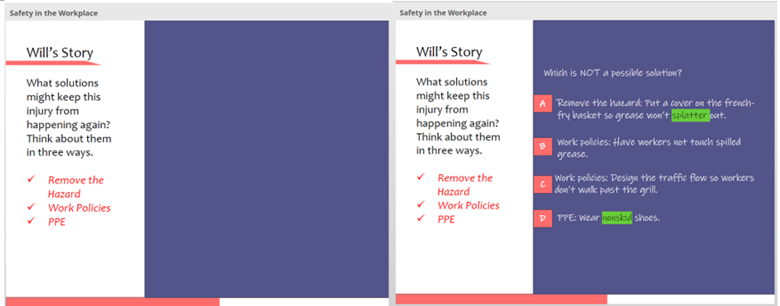
Safety in the workplace for ESL
I modified the National Institute for Occupational Safety and Health’s (NIOSH) Youth@Work—Talking Safety curriculum to better suit the needs of adult English as a Second Language (ESL) learners in the state of Maryland. Specifically, this modified curriculum aims to provide a foundation in workplace safety and health for adult ESL learners and help them understand their rights and responsibilities as employees in the United States.
The students participating in this curriculum are at the intermediate level of English proficiency and are looking to improve their vocabulary related to health and safety in the workplace, as well as their communication skills for describing their rights and responsibilities. With these goals in mind, I began the design process by setting clear objectives and outlining the scope and frame of the project.

To create an engaging and immersive e-learning experience, I developed a visual storyboard and interactive prototype using Articulate Rise 360. This allowed me to specify the events and interactions that would take place on each slide of the curriculum. I then used this design phase in Rise 360 as a foundation for fully developing the project in Storyline 360.
Visual storyboard and interactive prototype created in Rise 360
To aid in the understanding and critical thinking of the ESL learners, I employed several features in the curriculum. First, I created short videos with a typing effect in Adobe Express to effectively deliver the main highlights of the content to the students.
An MP4 video for a highlight
I also used hotspots and layers to present key vocabulary terms and used tooltips to display definitions and pictures to help the students understand these words.
Additionally, I employed animations to delay the transition of content and encourage students to think critically about safety problems and prevention. For example, I included delayed quizzes that allowed students to have time to think about possible solutions for the hazards presented in each scenario (as described by Andre, Will, and Anita).

This project provided several benefits to adult ESL learners in Maryland, including:
- Increased knowledge of workplace safety and health,
- Improved understanding of their rights and responsibilities as employees in the US,
- Enhanced critical thinking skills,
- Greater engagement with the learning process.
Overall, this project is a valuable resource for adult ESL learners in Maryland. It will help them to learn about workplace safety and health and to develop the skills and knowledge they need to be successful employees in the US.





